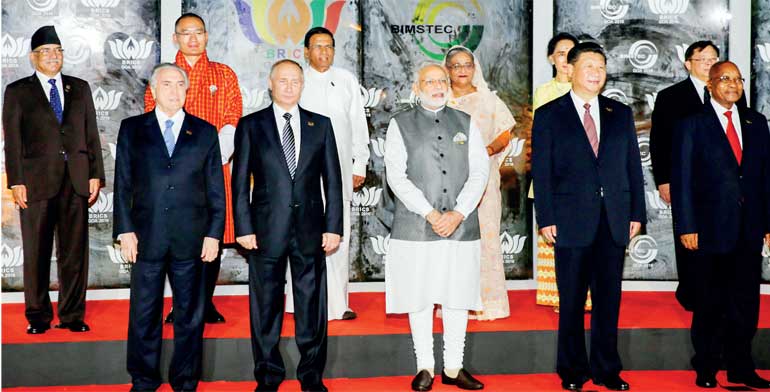Wednesday Jan 07, 2026
Wednesday Jan 07, 2026
Tuesday, 6 June 2017 00:05 - - {{hitsCtrl.values.hits}}
 President Maithripala Sirisena with BRICS Heads of State at the BIMSTEC Summit 2016
President Maithripala Sirisena with BRICS Heads of State at the BIMSTEC Summit 2016
The Bay of Bengal is rich in natural resources and embraces both South and East Asia. Although a number of regional groupings like Bangladesh-China-India-Myanmar (BCIM) and Bangladesh-Bhutan-Nepal-India (BBNI) partially cover the region, it is the Bay of Bengal Initiative for Multi-Sectoral, Technical, and Economic Cooperation (BIMSTEC) that covers the entire region and provides a framework for regional economic integration.
BIMSTEC accounts for $ 2.7 trillion GDP, 21% of global population (1.3 billion population) and 7% of intra-regional trade. BIMSTEC provides South Asian countries a conduit for economic cooperation with East Asia countries and a link to East Asian production networks and value chains. It can become a building block of a future Asian community; however, the progress so far has been exceedingly slow.
Launched in 1997, BIMSTEC began as a sectoral cooperation grouping partly to better utilise the natural resources in the region and partly to quicken integration of the region. Sectoral cooperation was broadened by extending it to many selected areas normally referred to as Multi-Sectoral Cooperation. Such cooperation is government-driven in contrast to mostly market driven integration through a Free Trade Agreement (FTA). BIMSTEC has identified a number of areas for sectoral cooperation such as tourism, fisheries, transport, etc.
BIMSTEC also envisaged a market-driven integration process when it first mooted an FTA in 2004. It was supposed to be in full operation by 2011, but did not become a reality by then. This is most probably because some member countries of BIMSTEC questioned the need for another FTA when the tariff levels in the region are already low. As it is well known, via unilateral liberalisation as well as through bilateral and regional liberalisation via the existing FTAs and RTAs (regional trading arrangements) in the region, the tariff levels have come down. Despite delays, a BIMSTEC FTA still remains in its agenda.
It is argued here that the two key functional aspects of BIMSTEC, which are market-driven integration and government-driven integration, should be utilised selectively to seek quick gains to the region.
As for market integration, BIMSTEC should not have high hopes on an FTA coming into operation. Indications are that it will drag on for a long time. In this situation, more emphasis should be given on trade facilitation via liberal transit, business-friendly customs, transport corridors, etc. Such a process will partly address some of the non-tariff barriers in the region and catalyse trade. According to the ESCAP, Trade Facilitation is a more powerful driver of trade than tariff reductions when tariff levels are already low, and this argument is aptly applicable to BIMSTEC.
As for government-driven integration, it is prudent to focus on a few sectoral cooperation projects related to connectivity and people-to-people contact rather than spreading too thin by focusing on a large number of sectoral cooperation projects. Road, rail and sea transport facilitation through road and rail links, transport corridors, multi-modal systems, transit arrangements, etc., which have been highlighted by the 2009 ADB Study on BIMSTEC Transport Infrastructure and Logistic Study (BTILS) needs to be worked on to improve connectivity. Perhaps digital connectivity may also be considered to strengthen physical connectivity. People-to-people contacts can be improved by improving air connectivity and tourism promotion via inter-governmental cooperation in the region. Buddhist circuit is one such example for BIMSTEC tourism promotion.
For sectoral cooperation to be effective, there needs to be strong institutions and information. Four areas need particular focus: BIMSTEC Secretariat; BIMSTEC Chamber of Commerce and Industry; external partners, viz., ADB and ESCAP; and interaction of  the BIMSTEC network of think tanks with BIMSTEC officials, and BIMSTEC Chamber.
the BIMSTEC network of think tanks with BIMSTEC officials, and BIMSTEC Chamber.
A strong Secretariat is required to push the activities of the regional grouping in between summits. The SAARC Secretariat has proved to be an ineffective body, whereas the ASEAN Secretariat has been able to drive the ASEAN agenda of the organisation more effectively. The BIMSTEC Secretariat needs to be similarly empowered like the ASEAN Secretariat, and delegated by member states to play a more proactive role in driving the BIMSTEC agenda. This becomes all the more important in the absence of a Charter for BIMSTEC.
BIMSTEC working mechanism has six layers: a leaders’ summit; ministerial meetings; senior officials meeting; expert group meetings; business and economic forums; and BIMSTEC Working Group (BWG). Basically, leaders’ summit to expert group meetings are at the inter-governmental level, and the new BIMSTEC Secretariat has absorbed all the work of the BWG. The business and economic forums should basically be absorbed by the BIMSTEC Chamber of Commerce and Industry located in Colombo, Sri Lanka. The Chamber should closely coordinate with the BIMSTEC Secretariat and drive the BIMSTEC economic integration agenda. The CUTS (India) proposal to have an annual BIMSTEC economic summit should be welcomed and should be closely coordinated with the BIMSTEC Chamber.
The external funder to facilitate BIMSTEC regional integration could be the ADB. The role ADB played in sub-regional cooperation in the Greater Mekong sub-region is well known. With the concurrence of the BIMSTEC member countries, the BTILS project can be initiated by the ADB. Thereafter, attracting additional funds to complete the project will not be a problem. However, duplication with the initiatives of BCIM and BBNI needs to be avoided. The Asian Highway that ESCAP suggested sometime back can also be part of the BIMSTEC connectivity and ESCAP can provide technical assistance to drive the project. Japan played a key role with FDI in ASEAN economic integration, likewise ADB and other external funding led connectivity improvement can catalyse BIMSTEC economic integration.
Finally, the role of think tanks cannot be overlooked in regional economic integration. They can play a crucial role as knowledge-partners of BIMSTEC. It is understood that there is both a Track 1 and Track 2 think tank networks for BIMSTEC. Both these tracks can interact with each other and network with the BIMSTEC senior officials and private sector to bring about necessary policy changes to activate sectoral cooperation.
When BIMSTEC started, India’s ‘Look East’ policy coincided with Thailand’s ‘Look West’ policy and there was much enthusiasm to drive the organisation by these two member countries to integrate a part of South Asia to the growing economies of East Asia. But since then, India and Thailand had embarked on an FTA and India and ASEAN had worked out an FTA. Thus both these member countries do not have the same enthusiasm to push the organisation for deeper integration as before. The other member countries are less powerful and passive partners of BIMSTEC. Thus BIMSTEC is no longer a member-driven organisation, and in this context, the Secretariat becomes vital in driving the organisation. Clearly, empowering the BIMSTEC Secretariat should become a priority of the member countries to keep the BIMSTEC Work Programme moving and producing gains to the people of the Bay of Bengal region.